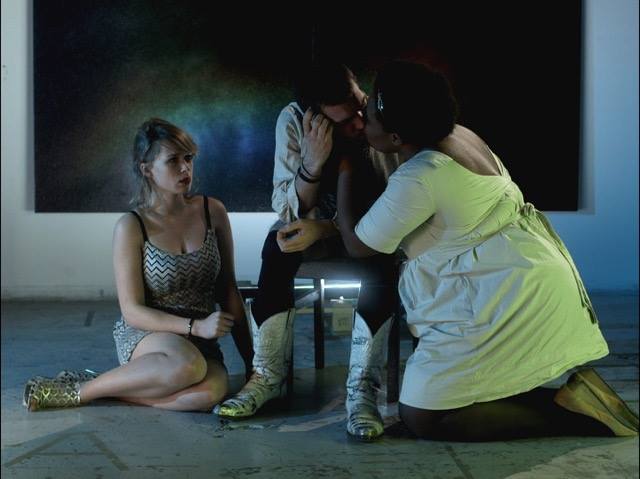Lunch with Ta bouche mon paradis (Your Mouth Is My Paradise)
Interview with Émilie Aussel, director of Ta bouche mon paradis (Your Mouth Is My Paradise)
Why did you want to make a film about feelings and human relations?
I’ve always been interested in that. In all of my films I try to paint a picture of our feelings. These have to do with group relations, our relations with others, our relation to loneliness, friendship, love. This film is my fourth short. My previous films centered on teenagers and their turmoil; in this one, the characters are young adults who engage in affective ploys.
More particularly, what interested you about the moments of aggression and dissatisfaction you portray in Ta bouche?
The film was written largely by the writer Emmanuelle Bayamack-Tam with whom I wrote Un Royaume [A Kingdom], the feature film I’m working on. I’d say that that particular tone is something that comes more from her than from me; it’s the feeling of our first romantic disappointments. The situations in this film highlight the fragility, giddiness and cruelty of desire and of those who experience it. The film is built on the young actors’ energy, on the emotional engagement of the characters and essentially exposes the pangs of love with irony and delicacy. It’s risky to be loved, and to love, and it’s very difficult for people to be understood…
How did you approach the relationships among the actors and how did you decide on the patterns, styles and outfits?
The film came out of a film workshop at the ERAC (the Cannes Regional Actors School, one of the twelve elite acting schools in France). They’d contacted me about doing a workshop on film acting, and when I saw how good the actors were and when Emmanuelle showed me her script, I pushed the exercise forward and we made this film. So straight off the bat I had a non-negotiable cast of fourteen actors, which is pretty unusual, but which helped us in the writing stages. The scenes involving two and three people were written for the actors, just for them. We rehearsed them over and over, tweaking them slightly. Emmanuelle gave us a basic version of the big choral scene, and over several days of improvisation we fleshed it out, which helped us imagine the relationships among the characters. This form of collective writing that involves the actors is something that I really like to do; I’ve experimented with it on my previous films. As for the film’s styles, colors and lighting, I wanted to make a relatively theatrical film, something that was over the top, highlighting the actors, their faces and their emotions. Their faces are the film’s landscapes, which explains our choice of the 4:3 (fullscreen) aspect ratio. The scenery is pretty pictorial, with bright colors, occasional artificial lighting and material inlays. Visually, I wanted to try something a little different from what I’d done previously, something more artificial. As for the outfits, we hunted through the ERAC’s costumes, and again I wanted to have some fun and give the characters an 80s feel, I wanted to play with the materials and colors in order to hone their respective personalities.
Are you particularly sensitive to the question of Gender, and is that a theme you’ve already looked at or that you play to look at more closely?
There too, the question of gender comes more from Emmanuelle than from me. It’s a theme that frequently reappears in her novels. I’d never dealt with it before in my films, but I did enjoy working on it and I might return to it in other projects. I’m curious about questioning masculine femininity and also in bringing out a certain feminism.
Finally, how did you work on the compositions and the sound? Were you especially trying to create a phantasmagorical, or at least a mysterious, effect?
Once we’d decided to shoot principally indoors or in empty urban spaces, I knew right from the beginning that we’d have to work on the sound in order to give depth to the spaces. The sound and music dramatize the scenes, giving them a certain hue, which reinforces the characters’ interactions by accentuating the tone of their words and relations. For example, in the fortunetelling scene with the dice, we added a storm and bursts of thunder to acknowledge the grand priestess’ comic effect. For the sound editing, I worked with Josefina Rodriguez, whom I’ve been working with for several years. As for the music, I again called upon the electronic drum duo Postcoïtum, who worked on my three previous films. I’m not so sure about phantasmagoria and mystery, though. We consciously thought out and crafted the sound and music to carry the characters. It may be that they also add an unreal, mysterious element. There is one musical motif that recurs several times, accentuating the characters’ loneliness, while also lending the film a lyrical, aerial quality. And lastly, the music at the party underlines tensions while also inviting the bodies to dance. Julio Iglesias sings about the undeniable difficulty of loving that the characters experience.
Any cinematic coups de cœur in the past year you’d like to tell us about?
Alain Guiraudie’s Staying Vertical and Albert Serra’s La mort de Louis XIV (The Death of Louis XIV).
Ta bouche mon paradis is being shown in National Competition F7.








